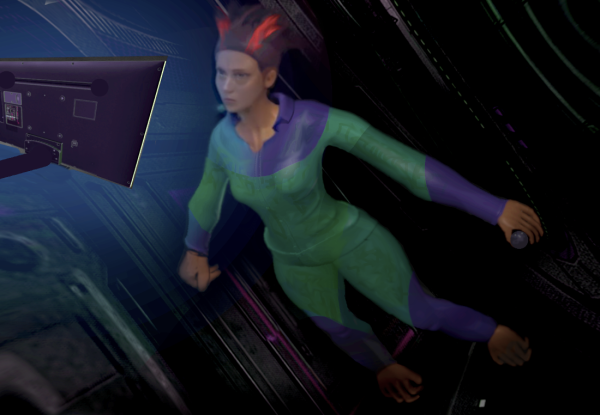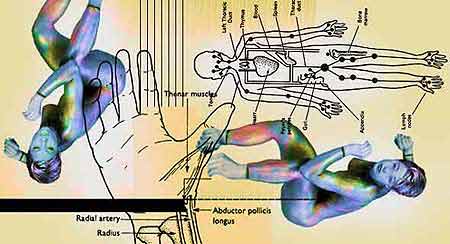BY LETTER
Space Adapted Human
Homo Cosmoi; Early microgravity-adapted humans. | |
 Image from Steve Bowers | |
| Space Adapted human from the Late Interplanetary Age; as well as flexible joints and prehensile feet, she is somewhat resistant to radiation damage and has a modified vestibular system to eliminate vertigo and spatial disorientation. | |
The powerful medical insurance companies (amongst others) were demanding new solutions to the health problems of workers in zero gee. There were severe medical problems with prolonged exposure to a zero gee environment, including bone degeneration and osteoporosis, muscle loss, and circulatory system weakness. A regime of exercise and medication mitigated the effects somewhat, but the cosmonauts often experienced permanent damage after several years in space. For several decades a form of gene therapy had been in use by the Chinese and some of the megacorporation ventures; based on the adaptation of various marine mammals to an essentially weightless environment, and running in parallel to the research into the development of aquatic human genotypes.
On Earth, the greatest goal of genetic enhancement was the potential extension of lifespan, and various forms of phenotypic gene therapy seemed to bring benefits in this area. Genetic modification had so far produced the talking chimpanzee, and the (biochip assisted) talking cat and dog, and a growing number of people with enhanced genome were being born each year (despite the UN restrictions). The superbright babies that were born towards the towards the beginning of the 2nd century AT (the end of the 21st century c.e.) were now young adults, and showed that genotypic modification was much more effective than gene therapy on grown individuals. When the first entirely new species of human, the Merpeople, were unveiled in AT 175, all further Inheritable Genetic Modification (IGM) was outlawed anywhere on Earth by a panicky UN special council.
Those groups of so-called Superbright Kids that had been sponsored by the GeneTEK megacorporation, including Nikolaus Vassiliou and his team, applied for, and gained, citizenship in the orbital Habitats. Together with the superturing AI systems and the augmented cyberheads that were the dominant faction in the orbital polities, Vassiliou and others forged ahead with the development of new types of genetically modified human outside the jurisdiction of the UN. Independently the Chinese Heavenly Palaces were developing their own groups of enhanced humanity, producing a so-called 'zero-gee child' in 2168 c.e.(199 AT). GeneTEK followed with their own version in 201.
.jpeg) Image from Vaktus |
Spaceships manned entirely by Space Adapted Humans came into regular service in 2192 c.e. (AT 223), and were soon the first choice for long haul manned space flight - between Earth and the new colony on Mars, the Belt development capital at Ceres, the US/Russian base at Pittsburgh Dva on Mercury and the GeneTEK/Jovian League rotating habitats near Jupiter. Rich energy resources around the giant planet attracted colonies on Europa, Ganymede, Callisto and Amalthea, all of which were predominantly financed by GeneTEK capital.
By this time Earth was rapidly changing, as the phenotypic gene therapy megacorporations such as Biotopia and Sarawara worked together to keep the IGM corporations like GeneTEK off the planet. Most countries and corporate republics relied heavily on Artificial Intelligence systems to control the availability of gene therapy for the treatment of disease and aging, and to regulate the new Neotek nanoassemblers, which were revolutionising the economy (and warfare). Political systems were thrown into turmoil by the rapid reaction times of the superturing planners, which allowed economic booms and slumps to occur in minutes instead of months, and alliances to be made and dissolved faster than unassisted humans could follow. To cope with the increased pace normal humans on the Hothouse Earth were adopting biochipped enhancements as well as the phenotypic gene therapies offered by the remaining biocorps. The offworlders withdrew from this complexity and began to build their own societies.
Very soon the solar system was divided into several superpowers, namely the Cislunar habitats, the Independent Martians, the Asteroid Belt and the Jovian League. The GeneTEK dominated Jovian League embraced inheritable genetic modification, and the Homo Cosmoi genome became incorporated into many of the new species that were created. Pure bred Cosmoi, however, were still living and working on the majority of the manned craft in the rest of the solar system, often ferrying heavily medicated normals from destination to destination. The microgravity-adapted space people became very powerful and colonised much of the outer solar system, and almost totally monopolised the long-distance trade routes, especially along the Hohmann (low speed) transfers where they undercut the prices even of the orbital-based megacorporations.
When Walli Day, a member of the racist hate group Aryan Human Front killed five Cosmoi on Clarke Orbital in 329 a.t. using a smuggled Lyse gun (made of totally organic bionanotech components that allowed it to pass the rigorous security), many Space People, already uncomfortable because of baseline ill-feeling, began to question the wisdom of associating with normals at all. They - and many concerned baseline activist groups like M.O.M (Mothers of Metahumans) and FoT (Friends of Tweaks) began to question how an uneducated and backburbs AHF member could have access to such advanced weaponry. It seemed that there were powerful reactionary forces working behind the scenes. Day's interrogators managed to extract the identity of the other members of his cell in a small Alabama Agribusiness Service Town, but they were long gone by the time the police raided. They were never again found and it is not known whether they had radical bio-surgery or simply were eliminated to stop them talking. Fingers were pointed at many suspect groups, including the Human Militia, the half a dozen groups called the Ku Klux Klan (all playing on anti-tweak fear among uneducated baselines when they weren't fighting among themselves as to which was the real KKK), the Christian Redemption (by this time already weakened through factionalism brought about through the public exposure of the sexual peccadilloes of the Right Reverend Josh Harrel) and the powerful Lobby for Democratic Values (who tended to lobby for anything but), and the rumour mill ran rife, but nothing was ever proven.
The increasing use of AI and robot pilots for ships was also cutting into Cosmoi livelihood. Meanwhile, in this climate of fear and uncertainty radical militant demagogues were also appearing among the Cosmoi, as well as elitist factions who exhorted the inherent superiority of the Space Adapted Human over the baseline, and even over other tweaks. In the middle of the 4th century a.t. Ignatius O'Neill (Cosmoi were frequently given surnames after the orbiting colonies where they were raised) taught that Space People - Homo cosmoi - would only be free once they could leave the oppressive baselines (or "apes", a common tweak term for unmodified humans) behind and have their own colonies and biospheres among the stars, their natural heritage and destiny.
The space people had already built up quite an empire and a great deal of wealth, but without the solid industrial base of the Jovian League they could never be a real superpower. Nevertheless they formed many family clans, guilds, and microstates, and by the early 5th century the Asteroid and Kuiper Belts and the Oort Cloud were studded with SAH biospheres. The space people played little role in the Genetekker rebellion. Between the two there were radical differences of psychology and lifestyle. The Space People considered the Genetekkers decadent hedonists; the Genen considered the Space People conservative and called them "petty tweaks" because of their reluctance to experiment with radical cladization and somatic morphing; it is evident from surviving records there was no love lost between the pure bred cosmoi and the Genetekker clades.
Related Articles
- Pantropy
- Sailors of the Ebon Sea
- Space People - Text by M. Alan Kazlev
[1] (archaic) A common early term for Space Adapted Humans, still used by some descendants of the original clade.
[2] (Integration period) A term for vacuum adapted tweaks, now rarely used. - Sritht
- Thicksuit
- Vacc-Suckers
- Vacuum Adapted Humans
- Vacuum Equipment
Appears in Topics
Development Notes
Text by M. Alan Kazlev and Steve Bowers
Initially published on 22 July 2000.
Bernd image added 2003
Vaktus image added 2020
Steve Bowers added August 2023
Initially published on 22 July 2000.
Bernd image added 2003
Vaktus image added 2020
Steve Bowers added August 2023







